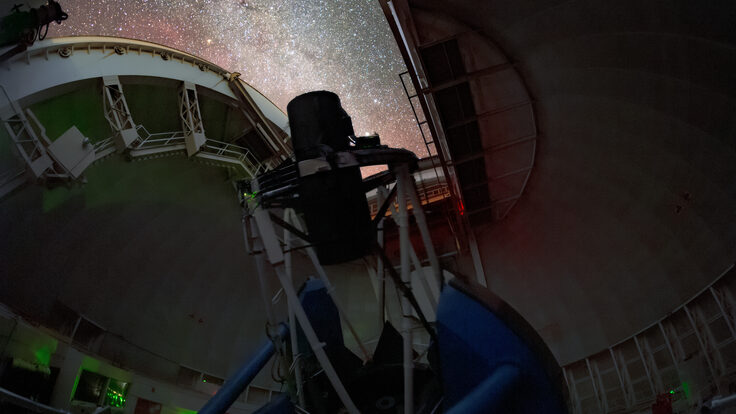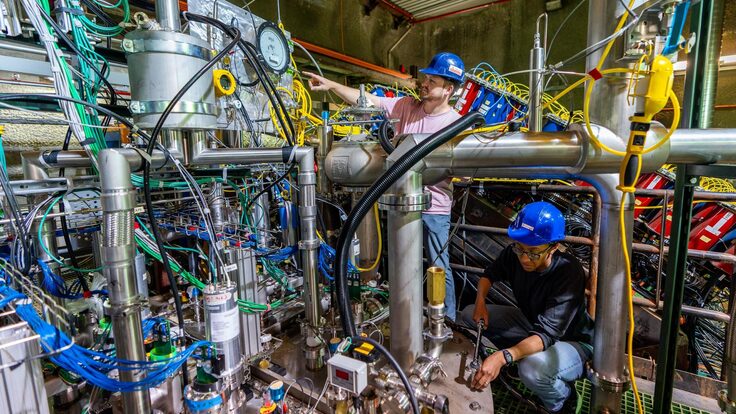
Andrew Hutton is sounding the call for leaner, greener accelerators – modern machines that propel high-energy particle beams with low energy usage.
His initiative, called CLEAN (Continuous wave Linac for Efficiency and Availability iNnovation), proposes exploring and testing newer technologies that would lead to higher-reliability, higher-efficiency particle accelerators.
“We should be investing to show we’re good stewards of the environment,” said Hutton, associate director of the Accelerator Division at Jefferson Laboratory in Virginia. “It seems to me a worthy goal.”
The aim of CLEAN is to find a way to cut a linear accelerator’s energy consumption in half and to reduce its downtime by a factor of five.
It isn’t only a matter of exercising environmental conscientiousness. Maximizing efficiency and minimizing accelerator downtime are crucially important for advancements in nuclear and particle physics, Hutton says. In future accelerator-driven systems (ADS), which can be used to generate nuclear energy for example, a machine’s stability has to be solid.
That rock-solid stability is par for the course in, say, synchrotron light sources, but it hasn’t yet been demonstrated for high-power linacs.
It’s an inconvenient but accepted truth that each cavity in a superconducting linac will break down a few hundred times a year for less than a minute in a machine that’s designed to run non-stop. One cause is the build-up of charge that creates electrical arcs, which can destroy parts of the accelerator cavities. To make sure the arc dies down, the power to the cavity has to be switched off for tens of seconds, and that’s time during which beam can’t run.
“If you can restore the power within about a second, it doesn’t matter,” Hutton said. “But on the other hand, 45 seconds? Way too long.”
To minimize beam-arresting interruptions, CLEAN proposes to reduce the recovery time to less than a second by more fully automating the recovery system. It also recommends exploring technologies that can prevent these trips from occurring in the first place, converting downtime to up time.
Hutton is offering up Jefferson Lab’s CEBAF accelerator as a proving ground for reliability testing. CEBAF currently uses a semi-automated recovery system for its 42 cryomodules (each containing eight radio-frequency cavities). In the CLEAN initiative, five of the cryomodules would be redesigned with even greater automation and their power sources rebuilt for higher availability. Since JLab has been tracking the accelerator’s downtime data since 1995, it also brings a library of beam trip stories to the table. A second possible test bed, the Spallation Neutron Source at Oak Ridge Laboratory in Tennessee, could also contribute JLab-built cavities and personnel for R&D.
In one year, researchers aim to shrink the recovery time to about 10 seconds. A year after that, they hope to have reduced it to less than one second.
And as long the accelerator’s up and running, why not get as much out of it as possible? The klystrons that power the CEBAF accelerator, once it’s completed a long-scheduled upgrade in 2015, will run at 50 percent efficiency. That low figure, though better than many, raises the point that decades-old klystron technology is overdue for a serious second look.
“Klystrons are very robust and they live a long time,” Hutton said. “There are good reasons for using them, but then there were also good reasons for ‘60s muscle cars.”
Newer but less well-known technological applications for accelerators, such as solid state drivers and magnetrons, could boost energy efficiency to 65, 70, even 90 percent. Right now these technologies either can’t operate at the frequency needed to power the accelerator cavities, about 1.5 GHz, or they can’t be pinned down to run reliably at that frequency. But they’re getting there. Solid state amplifiers, for example, have been able to operate at 1 GHz.
During an initial CLEAN phase, JLab scientists would give these cutting-edge components a redesign so they could serve as Energy Star equivalents for particle beam machines, which use tens of thousands of watts to move a particle from point A to point B.
“Yes, we use a hell of a lot of power here,” Hutton said. “Surely, we can do better than this.”






